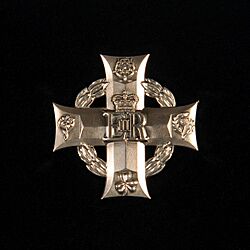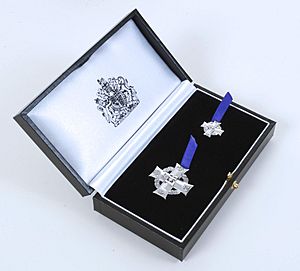Elizabeth Cross facts for kids
Quick facts for kids Elizabeth Cross |
|
|---|---|
 |
|
| Type | Commemorative emblem |
| Eligibility | Member of the British Armed Forces killed in action or died of wounds caused by military actions |
| Awarded for | Granted to the next of kin of servicemen and women who died during operations or were killed as the result of terrorist action since the Second World War |
| Status | Currently awarded |
| Description | Cross made of hallmarked silver carrying the rose of England, the Scottish thistle, the Irish shamrock, and the Welsh daffodil. The centre bears the crowned cypher of Queen Elizabeth II. The cross is backed by a representation of a laurel wreath. |
| Statistics | |
| Established | 1 July 2009 |
| Precedence | |
| Next (higher) | N/A |
| Equivalent | N/A |
| Next (lower) | N/A |
The Elizabeth Cross is a special award given to the closest family members of people in the British Armed Forces. It is for those who died while serving their country, or because of a terrorist attack, since January 1, 1948, after the Second World War. This award is named after Queen Elizabeth II.
Contents
What the Elizabeth Cross Looks Like
The Elizabeth Cross was designed by Dayna White. It is made from sterling silver, which is a very pure type of silver. The cross has a shape like a laurel wreath behind it. On the cross, you can see the national flowers of the United Kingdom: the rose for England, the thistle for Scotland, the shamrock for Ireland, and the daffodil for Wales. This design is similar to the Canadian Memorial Cross, which has been given out since 1919.
Families receive a larger version of the cross and a smaller one that can be pinned on. Both crosses feature the special symbol of Queen Elizabeth II.
The Memorial Scroll
Along with the cross, families also get a "Memorial Scroll." This scroll has the Royal Arms on it and is signed by the King or Queen of the United Kingdom. It also includes the name of the person who died.
When the award was first created, the scroll said:
This scroll commemorates
[rank][name]
[branch/regiment]
who gave his/her life for Queen and country
on the [date] day of [month] [year]
The words on the scroll were chosen by Andrew Motion, who was the official poet for the Queen at the time.
When the Award Started
Queen Elizabeth II officially created the Elizabeth Cross on July 1, 2009. However, it can be given to families of those who died even earlier, going back to the end of the Second World War. Before this award, families of those who died in the First World War received a memorial scroll and a bronze plaque. For those who died in the Second World War and the Korean War, families received a scroll.
The creation of the Elizabeth Cross was announced in the House of Commons by Bob Ainsworth, who was the Secretary of State for Defence. The Queen also announced it on the British Forces Broadcasting Service.
Official Rules for the Award
The official document that set up the Elizabeth Cross is called a royal warrant. It was signed by Queen Elizabeth II on July 1, 2009. This document stated that families of members of the Royal Fleet Auxiliary (which supports the Royal Navy) could also receive the award.
Receiving the Award
The first Elizabeth Crosses were given out by the Ministry of Defence on August 1, 2009.
Families can choose to receive the award in a public ceremony, presented by a local official called a Lord Lieutenant or a senior military officer. They can also choose a private ceremony. Only the closest family member receives the cross and the miniature version. However, other relatives can ask for extra copies of the Memorial Scroll.
The Ministry of Defence automatically processes awards for those who died since the year 2000. For those who died earlier, families need to contact the Ministry of Defence themselves. If families of those killed in the Korean War already received a scroll, they are now presented with only the cross.
First Public Presentation
The very first public presentation of an Elizabeth Cross happened on August 18, 2009. It was given to Karen Upton, whose husband, Warrant Officer Sean Upton, died while serving in Afghanistan. The award was presented by the Lord Lieutenant of North Yorkshire, the Lord Crathorne.
Queen Elizabeth II herself presented the Elizabeth Cross for the first time on September 12, 2009.
Who Can Receive the Award?
The Ministry of Defence has clear rules about who is eligible for the Elizabeth Cross:
- Those who died for any reason while serving in an operation where they earned a campaign medal. These medals show the risks involved in their service.
- Those who died because of a terrorist attack, if they were targeted because they were part of the UK Armed Forces.
- Those who died during a risky non-medal-earning task, where their death was caused by the danger of the task itself.
- Those who died later because of an injury or illness that happened during the situations mentioned above.
The service must have taken place on or after January 1, 1948. However, for those who served in Palestine, the date goes back to September 27, 1945.
The Secretary of State for Defence recommends who should receive the award to the King or Queen. The Ministry of Defence decides if someone meets the requirements. The names of all those honored with the Elizabeth Cross are kept in a special record by the Ministry of Defence.
The closest family member who receives the Cross can choose to wear it. In 2010, rules were made so that if the family member is also in the Armed Forces, they can wear the Elizabeth Cross on the right side of their uniform when other medals are worn.
Similar Awards
New Zealand Memorial Cross
Since the Second World War, New Zealand has also given a similar cross to the families of those who died while serving. This is called the New Zealand Memorial Cross. For example, it was recently given to the family of Lt. Tim O'Donnell and other soldiers' families who served in Afghanistan.
See also
- Elizabeth Emblem, a similar award for civilians
- List of wound decorations
- Victoria Cross
- George Cross


